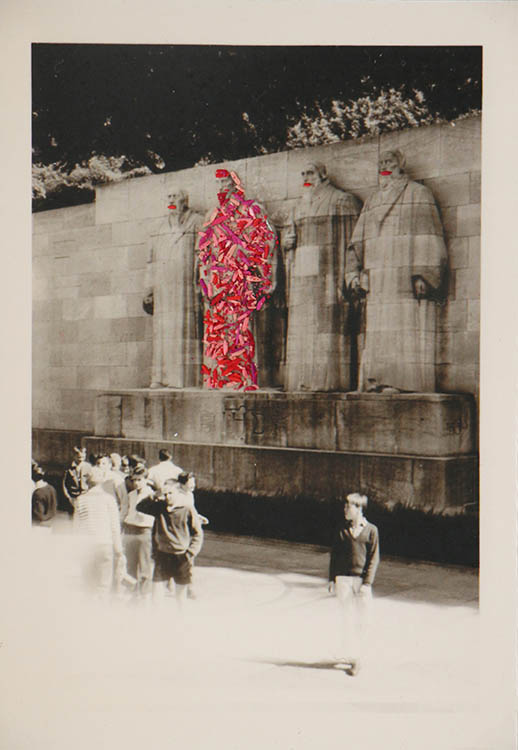Mali Genest
Sarah Hildebrand
Silvia von Niederhaüsern
A eulogy to absence
In her work Sarah Hildebrand has collected and preserved memories of absent people, known and unknown, like miniature treasures. Gathered into series the images bear witness to other epochs, to past celebrations and entertainments, or to a simple daily event which a departure has interrupted. The “De père en fille” (From father to daughter) series revisits the black and white photos that the artist’s father took when he was an adolescent. Onto these Sarah Hildebrand has added pieces of the core of coloured crayons as if appropriating in an almost childish manner a time when she did not yet exist. In “Lieux délaissés” (Abandoned places) she records the evidence of absence in apartments abandoned by their former inhabitants. She concentrates on details such as objects frozen in time, to tell stories about moments in life. There is no aesthetic or scenario, the objects and the lighting are allowed to tell the story. In the “Murmures” (Whispers) series, Sarah Hildebrand took her camera to three places in the former GDR: an amusement park, a manor, and a ballroom which had staged balls and shown films before the fall of the Wall. She photographed the bizarre sight of engines with monster heads and faded colours appearing to cut a path through vegetation busily reclaiming its lost territory. A ceiling, decrepit and peeling, or an old grand piano abandoned in an immense ballroom, capture the sounds of past revelries. Each series of pictures is published in a book format which varies according to the theme and which completes the artistic concept.
Mali Genest’s early training in needlework is evident in her subtle and elemental representation of the body. Corporality, as she sees it, is expressed in the dashes on pattern pieces superimposed on one another, the parallel lines reminding us of hair and the pink colour of butcher’s paper, flesh. An intensely feminine mood emerges from these references which is further emphasised where she uses nail varnish, sequins or knitting. This femininity, though, is not complacent. It rejects the usual clichés in order to tell stories made up of small gaps like a lost stitch or a break in a pattern. Black velvet pierced with nails or crimson hues on a fragment of skin, also speak of pain but in a more explicit way. Mali Genest’s technique is always in search of an aesthetic which sublimates her concept and anaesthetises observation, at least initially. Even if we know nothing about the artist’s life experience and the everyday activities on which these works are based, their power does not rely on anecdote, it lies in their profound humanity.
Silvia von Niederhaüsern paints coloured circles freely but with concentration on different sized sheets of paper in both landscape and portrait orientations. She chooses the colours with care alternating closely related tones with multi-coloured compositions, opaque or transparent, solid or in outline. In spite of the extreme simplicity of her language of circles and sometimes squares, each work is unique and recognisable as if the artist wants to produce an extremely detailed catalogue of the infinite possibilities of colour combinations. When questioned about her choice of colours and forms, she invariably says (in Swiss German), “I don’t know”, like a protective barrier against the absurdity of the question. Her paintings and drawings with their seductive and sensual interplay of colours go beyond intellect and touch the senses. While observing these images, remembered tastes and perfumes slowly emerge, vibrant and alive. It is at such moments, in the confusion of shared delights and memories, that communication with the artist’s work is achieved.
By freely mixing all artistic schools including Art Brut (Outsider Art), the 55th Venice Biennale (2013) showed the rewards which flow after taking away boundaries, and the fascinating dialogues which may follow between contemporary artists from the academic world and those called “outsiders”. Our exhibition adopts this approach in presenting the paintings of Silvia von Niederhaüsern who works in the CREAHM studio at
Villars-sur-Glâne. Benefitting from the advice of professionals in the contemporary arts, the intellectually disabled artists who work there are genuinely talented and have free-flowing and refreshing imaginations which is the source of their originality. Silvia von Niederhaüsern has been involved in the CREAHM workshop since 2011 and has taken part, since 2013, in many exhibitions (Centre suisse de pédagogie spécialisée, Bern; Théâtre Nuithonie, Villars-sur-Glâne; Homato, fondation les Buissonnets, Fribourg).


